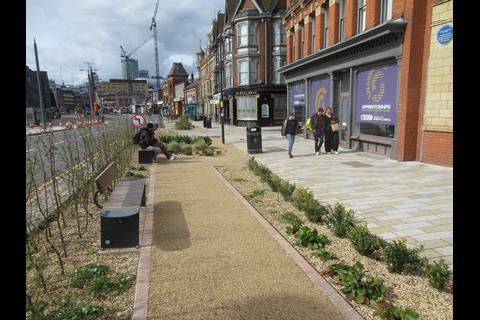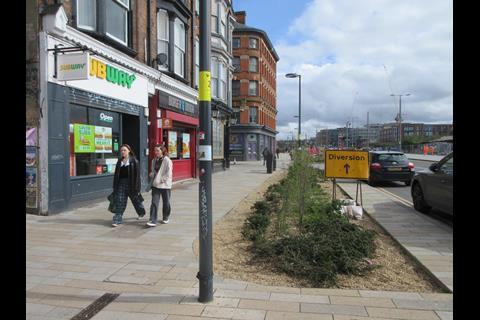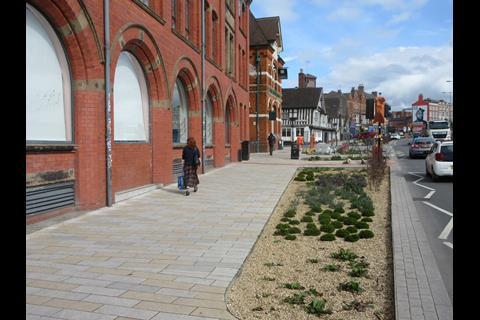Birmingham’s latest public realm improvement brings with it some expensive maintenance liabilities, writes Joe Holyoak

There was an interesting session in the Urban Design Group’s (UDG) annual conference in Sheffield last October, on the current rethinking of street design which is going on in a lot of different places. A common theme is the reduction in the highway space devoted to motor vehicles, and its re-dedication to different purposes.
One of the contributions was from the landscape architect Zac Tudor of Arup. He promoted the idea of less heavily-trafficked streets containing more greenery and SuDS (sustainable drainage systems), as has happened in Sheffield’s award-winning Grey to Green scheme.
In my conference report in the UDG publication Urban Design, I speculated that, extensively pursued, this policy would require local authorities to employ many more council gardeners, who would perhaps be given a higher employment status than the fairly low ranking which they presently have.
There is a street redesign currently taking place in Birmingham which exemplifies Zac Tudor’s idea. High Street Deritend was until recently possibly the most hostile and unpleasant street in the city centre. Ironically so, as it is an historic, winding street which once connected the mediaeval town clustered around the moated manor house and the market place of the Bull Ring with the suburb of Deritend, on the other side of the river Rea.
Some fine buildings survive on the northern side, but the southern side was demolished a hundred years ago, and a wide dual carriageway built. The key decision leading to its current transformation was to locate a new Metro tram line there. Eventually it may lead to the airport, but in Phase 1 it will connect to the Curzon Street HS2 terminal and go only as far as the Custard Factory in Digbeth.
Some years ago I observed that High Street Deritend has a similar width to Las Ramblas in Barcelona, about 33 metres, and proposed that its redesign could give Birmingham a similar grand pedestrian boulevard. This is now happening, up to a point. Six lanes of traffic are being reduced to two. Tram lines are in place, although trams are unlikely to be running until 2027.
Because of the orientation of the street, I suggested that the main pedestrian promenade, instead of being in the centre as in Barcelona, should be on the northern side, where it will receive more sunshine. This has been done, and the paving is in place. However, the opportunity to provide a generous pedestrian realm has not been taken.
Large parts of the pedestrian promenade have been devoted to low-level planting: in some places narrowing the walkable part to a zone no wider than what was there before the reshaping. There are two areas for concern here.
Firstly, the opportunity to have extensive space where people can wander, gather freely, socialise in pleasant surroundings, sitting or standing, as in Las Ramblas, has been lost. The planted areas are areas for non-occupation by people.
Secondly, who is going to maintain these planted areas? The City Council is currently in financial crisis: there are colossal bills to be paid, and government commissioner Max Caller and his team are in the Council House, deciding what council programmes can and cannot be funded.
Funding to arts budgets is being stopped, and several sectors vital to public life, such as branch libraries, are threatened with closure. Is it likely that more council gardeners will be employed to maintain the new planting? I suspect not.
When I suggested the Ramblas comparison, I advocated that it was essential that the reshaping of High Street Deritend should include an avenue of London Plane trees, just as in Barcelona, to give shade and to enclose space. This is not happening, as there is no budget for a lot of trees.
The City Council’s vision for the transformation of the city centre, Our Future City Plan, published in 2021, contained absurd aerial CGIs which showed isolated high-rise towers rising out of Amazonian jungle-like forests of trees. Some of these images now appear to have been modified to show more modest tree cover. But they are trees which the city evidently cannot afford.
Birmingham seems to have a problem with urban public spaces which are not containers for something else. It has a fine record over the past 35 years in shaping good quality spaces: Centenary Square, Brindleyplace Square, Victoria Square, the ‘boulevarding’ of Smallbrook Queensway.
But it seems to have an impulse to then fill those spaces with other things – Christmas market, ice rink, big wheel, funfair, Brazilian jungle – in order to justify the spaces, as though simply having well-designed spaces for citizens and visitors to walk and sit down in is not enough. The reshaping of High Street Deritend, catalysed by the metro line, was an opportunity to reduce the traffic and to expand pedestrian space in a civilised and sociable way.
The traffic will be reduced, but the areas of low-level planting also reduce the available pedestrian realm. I fear that in a city struggling to pay for essential public services, they will end up as poorly-maintained traps for windblown litter, and residents will have less space to stroll than they might otherwise have had.
>> Also read: Is Birmingham’s vision for a greener, high-density city centre achievable?
Postscript
Joe Holyoak is an architect and urban designer practising in Birmingham



















2 Readers' comments